Tripartite Evolutionary Game Analysis of Product Quality Supervision in Live-Streaming E-Commerce
Abstract
:1. Introduction
2. Literature Review
2.1. Quality Issues in Live-Streaming E-Commerce
2.2. Consumer Live Purchasing and Rights Protection Behavior
2.3. Evolutionary Game Theory
3. Model Assumptions and Construction
- (i)
- There are a large number of products on the market, but their quality and variety are uncertain. Therefore, social media influencers need to manage product quality control before selling their products. The optional strategies are strict quality control and lax quality control, corresponding to the probability of and , respectively.
- (ii)
- Lax quality control can reduce the costs in terms of time and energy in the quality control process, such as qualification reviews, sample evaluation, and production tracking, so the cost of strict quality control is higher than the cost of lax quality control. At the same time, lax quality control can increase cooperation with brands and the richness of products and thus obtain more admission fees and commission revenue. Considering the cost of quality control, admission fees, and commission revenue, when social media influencers choose lax quality control, the risk–return factor is introduced to indicate a positive impact on the revenue. If the gain with strict quality control is R, then the gain with lax quality control is .
- (iii)
- In real life, the strictness of product quality control is directly related to the possibility of product problems. The stricter the quality control, the lower the risk of product problems. When social media influencers choose strict quality control, the possibility of product problems is ; when quality control is lax, the possibility of product problems is .
- (i)
- Live-streaming e-commerce platforms have an important responsibility to ensure fair trading in terms of supervision. Therefore, platforms need to regulate the behavior of social media influencers. The available strategies are strong and weak supervision, with corresponding probabilities of and , respectively.
- (ii)
- Social media influencers need to cooperate with e-commerce platforms such as TikTok, Taobao, and Jingdong for live-streaming. These platforms provide channel resources and service support for social media influencers to carry out live-streaming. Therefore, platforms will take an h-percentage of the earnings of social media influencers.
- (iii)
- When a platform chooses strong supervision, the platform always needs to prepare for more human and resource costs to cope with feedback on consumers’ rights protection.
- (iv)
- The platform’s punishment for social media influencers who sell inferior products is . In this situation, when the platform chooses strong supervision, the reputation loss of social media influencers is , where E indicates the reputational loss of the social media influencers in the presence of weak supervision, and indicates the positive impact of strong supervision on market order.
- (v)
- When a platform carries out strong supervision, consumers who choose to defend their rights assist the platform to a certain extent in rectifying the live-streaming e-commerce environment, thus bringing the potential market governance benefits J.
- (vi)
- When a platform carries out weak supervision, consumers who defend their rights will turn to other competitive platforms due to a poor shopping experience, resulting in commercial losses. When social media influencers choose strict quality control, the platform’s commercial loss is ; when social media influencers choose lax quality control, the platform’s commercial loss is .
- (i)
- When consumers face problematic products, the strategy they can choose is defending their rights or not defending their rights, and the corresponding probabilities are and , respectively.
- (ii)
- Consumers’ purchase decisions are mainly driven by two motivations: functional motivation and emotional motivation. The functional value that consumers gain by purchasing products is N. Functional value refers to the inherent performance and attributes of a product. When consumers buy products to meet their needs in life, that is, they pay more attention to the functional value of the product, and they tend to defend their rights. The emotional value that consumers gain by purchasing products is W. Emotional value refers to the emotional support consumers show for social media influencers. When consumers have fanatical emotional devotion and loyalty to social media influencers and express their support by placing orders, that is, consumers pay more attention to the emotional value of the product, and they tend not to defend their rights.
- (iii)
- When consumers choose to defend their rights, the time costs of communicating with the platform and proving their point are .
- (iv)
- The possibility of successful consumer rights protection is positively correlated with the regulatory intensity of live-streaming e-commerce platforms. The stronger the supervision, the higher the probability that consumers will successfully defend their rights. When a platform chooses strong supervision, the probability of effectively addressing the consumer rights protection problem is , and the compensation received by the consumer is ; when the platform chooses weak supervision, the probability of effectively addressing the consumer rights protection problem is , and the compensation received by the consumer is .
- (v)
- When social media influencers choose strict quality control or lax quality control, the loss of rights and interests resulting from consumer purchases is or , respectively.
4. Stability Analysis
4.1. Social Media Influencers
- (1)
- When , we obtain . Then, is the only ESS.
- (2)
- When , we obtain . Then, is the only ESS.
4.2. The Live-Streaming E-Commerce Platform
4.3. Consumers
- (1)
- When , we can obtain . At this point, is the only ESS.
- (2)
- When , we can obtain . At this point, is the only ESS.
4.4. The Tripartite Evolutionary Game System
- (1)
- When , the evolutionarily stable strategy for the system is .
- (2)
- When , the evolutionarily stable strategy for the system is .
- (3)
- When , the evolutionarily stable strategy for the system is .
- (4)
- When , the evolutionarily stable strategy for the system is .
- (5)
- When , the evolutionarily stable strategy for the system is .
5. Sensitivity Analysis
5.1. Impacts of Social Media Influencers
5.1.1. The Risk–Return Factor
5.1.2. The Ratio of the Probability of Product Problems under Different QC Strategies
5.2. Impacts of the Live-Streaming E-Commerce Platform
5.2.1. Commercial Losses
5.2.2. Strong Supervision Costs and Market Governance Benefits
5.2.3. Percentage of Platform Commissions
5.3. Impacts of Consumers
5.3.1. Functional Value and the Success Rate of Rights Protection
5.3.2. Emotional Value
6. Conclusions and Management Implications
6.1. Conclusions
- (i)
- In the evolutionary game system of live-streaming e-commerce, there are five possible evolutionarily stable strategies for the system. They are lax quality control, weak supervision, and no rights protection; lax quality control, weak supervision, and rights protection; strict quality control, weak supervision, and rights protection; lax quality control, strong supervision, and rights protection; and strict quality control, strong supervision, and rights protection.
- (ii)
- When the emotional value obtained by the consumers exceeds the compensation obtained by the consumers through rights protection and the actual value of the products minus the cost of rights protection, the strategy of the three parties will eventually stabilize at lax quality control, weak supervision, and no rights protection. In this context, the live-streaming e-commerce industry faces an undesirable phase of development driven by excessive consumer fandom.
- (iii)
- Consumers’ purchase decisions under different motivations will affect their choice of rights protection. When the functional value of the products is higher, consumers are more motivated to choose a rights defense strategy. In this context, the strategic equilibrium state for social media influencers will undergo a leap, and the strategic choice will shift from a lax quality control strategy to a strict quality control strategy. When the purchase of products brings higher emotional value to consumers, consumers are more inclined not to defend their rights, and the strategy of social media influencers stabilizes at lax quality control. In this context, the strategic equilibrium state for the live-streaming e-commerce platform will jump, shifting from strong supervision to weak supervision.
- (iv)
- A higher risk–return factor or a lower probability of quality problemscan make social media influencers more motivated to choose a lax quality control strategy. As the difference in the probability of quality problems continues to increase, the equilibrium strategy will shift from lax quality control to strict quality control. It should be noted that if the platform’s punishment for quality problems is lower, the effect of the probability of quality problems is not significant, and this will not motivate influencers to change their strategy. Another interesting finding is that a high percentage of platform commissions can encourage influencers to implement strict quality control, while the platforms can maintain weak supervision.
6.2. Management Implications
- (i)
- Social media influencers should establish a rigorous collaborative screening mechanism, conducting a thorough qualification review and credibility assessment of potential partners, for example, gaining an in-depth understanding of a merchant’s market reputation and its product quality management system. Consumers have higher expectations and sensitivity to the quality of products with a high functional value, and social media influencers must adopt stricter quality control measures when promoting and selling these high-value goods. This can help to reduce consumer dissatisfaction and complaints arising from quality issues. In the event of product quality problems, social media influencers should take a positive and sincere attitude, apologize to consumers and compensate them according to the law, and promise to strictly control the quality of their products in the future and accept consumers’ supervision at all times. In addition, social media influencers can enhance the transparency of their operations by disclosing their selection criteria and quality control processes, such as listing the key factors considered in product selection and displaying product-related quality certifications and testing reports. Social media influencers should become quality guardians and trust-maintainers to maintain long-term competitiveness and promote the healthy and sustainable development of the industry.
- (ii)
- Live-streaming e-commerce platforms should use data mining algorithms to conduct an in-depth analysis of massive data resources such as transaction history and consumer rights protection records to identify areas with a high incidence of product quality problems, changing trends in social media influencers’ reputations, and hot topics within consumer complaints. At the same time, relying on artificial intelligence and big data analysis, an intelligent risk warning model can be built to effectively identify possible violations on the basis of lax quality control by social media influencers. For live-streaming business activities judged as high-risk, platforms should establish a quick response mechanism. Once it is found that there are product quality problems in live-streaming, platforms must punish this severely, such as lowering credit ratings, suspending live-streaming for some time, or even banning it to constrain and regulate the product selection behavior of social media influencers. In addition, to improve the quality of service of their platforms, platforms need to establish perfect training systems, improve the work efficiency and problem-solving abilities of their customer service specialists, and reduce the waiting time for feedback on user rights. Furthermore, consumers’ rights protection behavior will deter social media influencers from lax quality control somewhat, so it plays a key role in the product quality governance system. Platforms should encourage consumers to participate in the daily governance of the platform and strengthen the enthusiasm of consumers for participating in supervision. For example, platforms can set up a public honor roll to recognize consumers who actively participate in feedback and make constructive comments. They can also receive exclusive coupons or sweepstakes. These incentive mechanisms aim to strengthen consumer supervision of social media celebrities and encourage them to cooperate with e-commerce live-streaming platforms in carrying out co-governance.
- (iii)
- For consumers, it is crucial for them to maintain rational consumption choices. In the context of live-streaming with goods, the consumption model based on the fan economy often leads to the excessive involvement of emotional factors in consumers’ decision-making processes, which is not conducive to the creation of a rational and healthy consumption environment. Consumers need to maintain a certain distance from social media influencers and avoid excessive investment of time and energy. In addition, consumers should make purchase decisions based on objective product information and their actual personal needs and avoid irrational consumer behaviors due to blind admiration and following of influencers, which is conducive to managing product quality issues in live-streaming. Consumers can set a shopping budget for themselves and regularly assess whether their consumption behavior is in line with their personal consumption philosophy and life goals. If consumers encounter product quality problems, they should actively defend their rights to platforms to safeguard their legitimate rights and interests and assist the platform in effectively managing unregulated behavior on the part of social media influencers. When influencers or platforms fail to deal with problems, consumers should pursue their rights through other legal channels, forcing social media influencers to improve the strictness of their product selection and urging platforms to strengthen their supervision efforts. In summary, rational consumer purchasing behavior and active rights protection actions can help promote a more standardized and healthy live-streaming e-commerce environment.
6.3. Limitations and Future Research
Supplementary Materials
Author Contributions
Funding
Data Availability Statement
Conflicts of Interest
Abbreviations
| ESS | Evolutionarily Stable Strategy |
| RDE | Replicated Dynamic Equation |
| QC | Quality Control |
Appendix A. The Expected Returns of the Three Subjects
References
- Xin, B.; Hao, Y.; Xie, L. Strategic product showcasing mode of E-commerce live streaming. J. Retail. Consum. Serv. 2023, 73, 103360. [Google Scholar] [CrossRef]
- Xiao, P. The rise of livestreaming e-commerce in China and challenges for regulation: A critical examination of a landmark case occurring during COVID-19 pandemic. Comput. Law Secur. Rev. 2024, 52, 105955. [Google Scholar] [CrossRef]
- Sun, Y.; Wu, D.; Yang, Y.; He, H. Exploring online celebrities and reviews simultaneously-the role of their consistency in different product types. Electron. Commer. Res. Appl. 2024, 65, 101384. [Google Scholar] [CrossRef]
- Chen, T.; Peng, L.; Yang, J.; Cong, G.; Li, G. Evolutionary game of multi-subjects in live streaming and governance strategies based on social preference theory during the COVID-19 pandemic. Mathematics 2021, 9, 2743. [Google Scholar] [CrossRef]
- Lee, H.H.; Kim, J.; Fiore, A.M. Affective and cognitive online shopping experience: Effects of image interactivity technology and experimenting with appearance. Cloth. Text. Res. J. 2010, 28, 140–154. [Google Scholar] [CrossRef]
- Dimoka, A.; Hong, Y.; Pavlou, P.A. On product uncertainty in online markets: Theory and evidence. MIS Q. 2012, 35, 395–426. [Google Scholar] [CrossRef]
- Lu, B.; Chen, Z. Live streaming commerce and consumers’ purchase intention: An uncertainty reduction perspective. Inf. Manag. 2021, 58, 103509. [Google Scholar] [CrossRef]
- Liu, J.; Wu, Q.; Zhang, M. Evolutionary game of value co-destruction of the ecosystem of live commerce platform. Chin. J. Manag. Sci. 2022, 31, 143–154. [Google Scholar]
- Li, L.; Chen, X.; Zhu, P. How do e-commerce anchors’ characteristics influence consumers’ impulse buying? An emotional contagion perspective. J. Retail. Consum. Serv. 2024, 76, 103587. [Google Scholar] [CrossRef]
- Zhang, Y.; Zhang, T.; Yan, X. Understanding impulse buying in short video live E-commerce: The perspective of consumer vulnerability and product type. J. Retail. Consum. Serv. 2024, 79, 103853. [Google Scholar] [CrossRef]
- Wang, L.; Zhang, R.S.; Zhang, C.X. Live streaming E-commerce platform characteristics: Influencing consumer value co-creation and co-destruction behavior. Acta Psychol. 2024, 243, 104163. [Google Scholar] [CrossRef]
- Wang, J.; Wu, Y.; Wang, Q.; Li, J. Research on the Relationship between E-commerce Anchor Attributes, Consumer Trust and Purchase Intention—The moderating effect based on commodity price and reputation of e-commerce platform. Theory Pract. Prices 2021, 41, 151–154. [Google Scholar]
- Lu, Y.; He, Y.; Ke, Y. The influence of e-commerce live streaming affordance on consumer’s gift-giving and purchase intention. Data Sci. Manag. 2023, 6, 13–20. [Google Scholar] [CrossRef]
- Wang, C.; Liu, T.; Zhu, Y.; Wang, H.; Wang, X.; Zhao, S. The influence of consumer perception on purchase intention: Evidence from cross-border E-commerce platforms. Heliyon 2023, 9, e21617. [Google Scholar] [CrossRef] [PubMed]
- Chen, J.; Gong, X.; Ren, R. Active or avoidance coping? Influencing mechanisms of streamers’ coping strategies on viewers’ word of mouth after livestreaming e-commerce failures. J. Retail. Consum. Serv. 2023, 72, 103278. [Google Scholar] [CrossRef]
- Kowert, R.; Daniel, E., Jr. The one-and-a-half sided parasocial relationship: The curious case of live streaming. Comput. Hum. Behav. Rep. 2021, 4, 100150. [Google Scholar] [CrossRef]
- Huang, L.; Ma, L. A protective buffer or a double-edged sword? Investigating the effect of “parasocial guanxi” on consumers’ complaint intention in live streaming commerce. Comput. Hum. Behav. 2024, 151, 108022. [Google Scholar] [CrossRef]
- Szabó, G.; Fath, G. Evolutionary games on graphs. Phys. Rep. 2007, 446, 97–216. [Google Scholar] [CrossRef]
- Wang, M.; Li, Y.; Cheng, Z.; Zhong, C.; Ma, W. Evolution and equilibrium of a green technological innovation system: Simulation of a tripartite game model. J. Clean. Prod. 2021, 278, 123944. [Google Scholar] [CrossRef]
- Zhang, X.; Guo, X.; Zhang, X. Collaborative strategy within China’s emission trading scheme: Evidence from a tripartite evolutionary game model. J. Clean. Prod. 2023, 382, 135255. [Google Scholar] [CrossRef]
- Liu, Y.; Dong, F. What are the roles of consumers, automobile production enterprises, and the government in the process of banning gasoline vehicles? Evidence from a tripartite evolutionary game model. Energy 2022, 238, 122004. [Google Scholar] [CrossRef]
- Xu, Z.; Cheng, Y.; Yao, S. Tripartite evolutionary game model for public health emergencies. Discret. Dyn. Nat. Soc. 2021, 2021, 6693597. [Google Scholar] [CrossRef]
- Wang, L.; Schuetz, C.G.; Cai, D. Choosing response strategies in social media crisis communication: An evolutionary game theory perspective. Inf. Manag. 2021, 58, 103371. [Google Scholar] [CrossRef]
- Fan, W.; Wang, S.; Gu, X.; Zhou, Z.; Zhao, Y.; Huo, W. Evolutionary game analysis on industrial pollution control of local government in China. J. Environ. Manag. 2021, 298, 113499. [Google Scholar] [CrossRef] [PubMed]
- Liu, J.; Ai, S.; Du, R.; Brugha, C.M. Analysis of commodity traceability service effects on the purchase behavior of consumers using an evolutionary game model. Data Sci. Manag. 2022, 5, 175–186. [Google Scholar] [CrossRef]
- Li, C.; Li, H.; Tao, C. Evolutionary game of platform enterprises, government and consumers in the context of digital economy. J. Bus. Res. 2023, 167, 113858. [Google Scholar] [CrossRef]
- Ritzberger, K.; Weibull, J.W. Evolutionary selection in normal-form games. Econom. J. Econom. Soc. 1995, 63, 1371–1399. [Google Scholar] [CrossRef]
- Lyapunov, A.M. The general problem of the stability of motion. Int. J. Control 1992, 55, 531–534. [Google Scholar] [CrossRef]
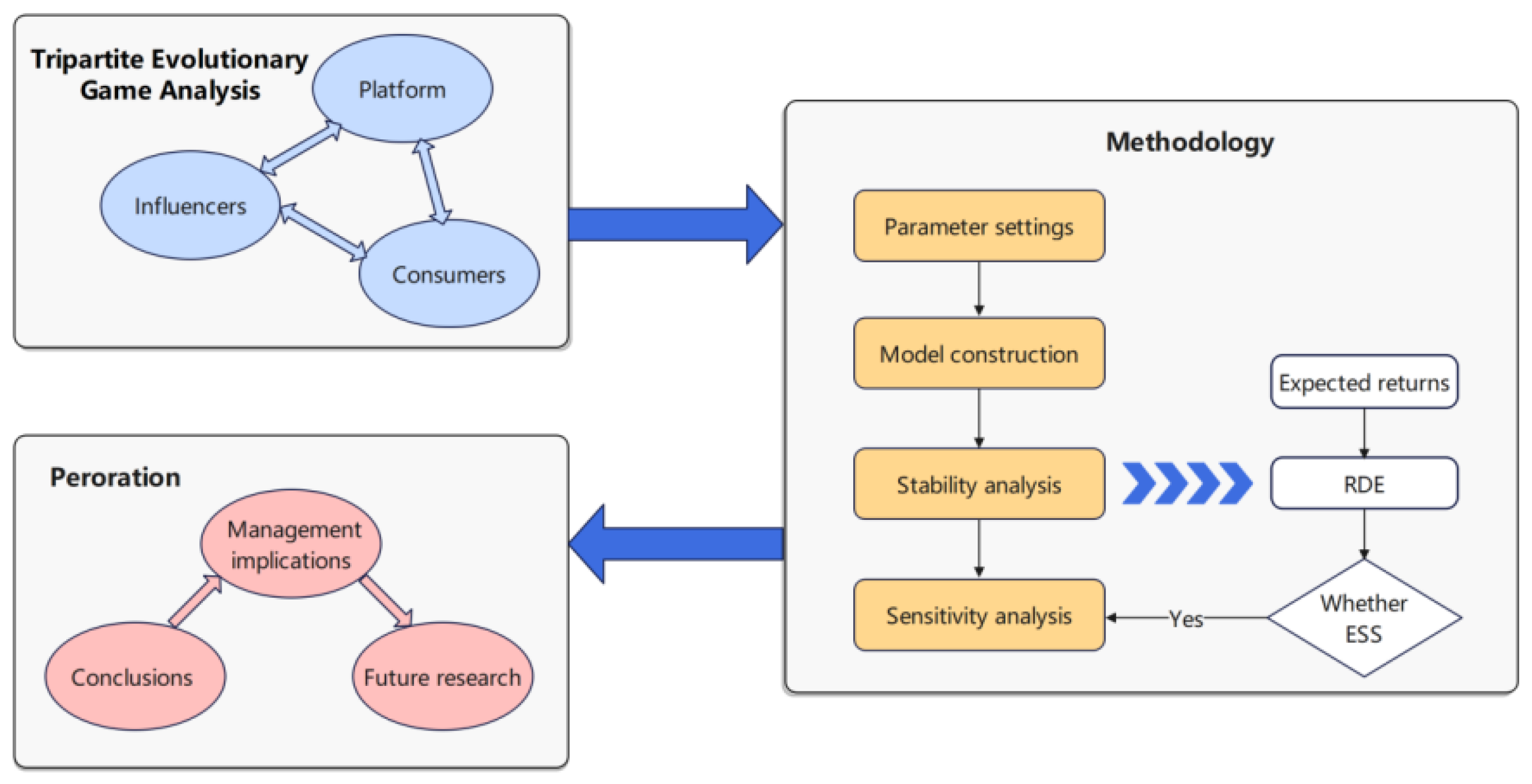




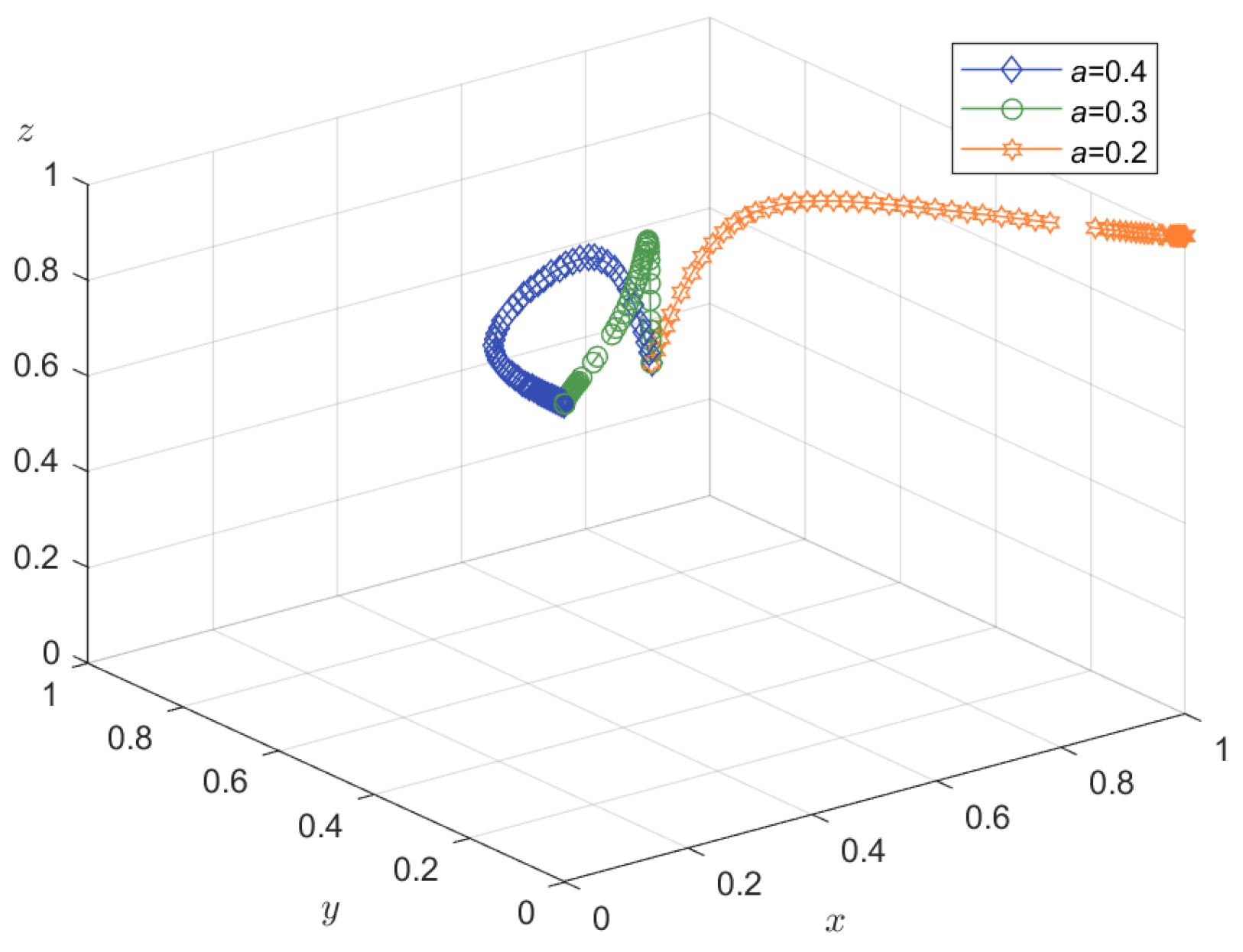
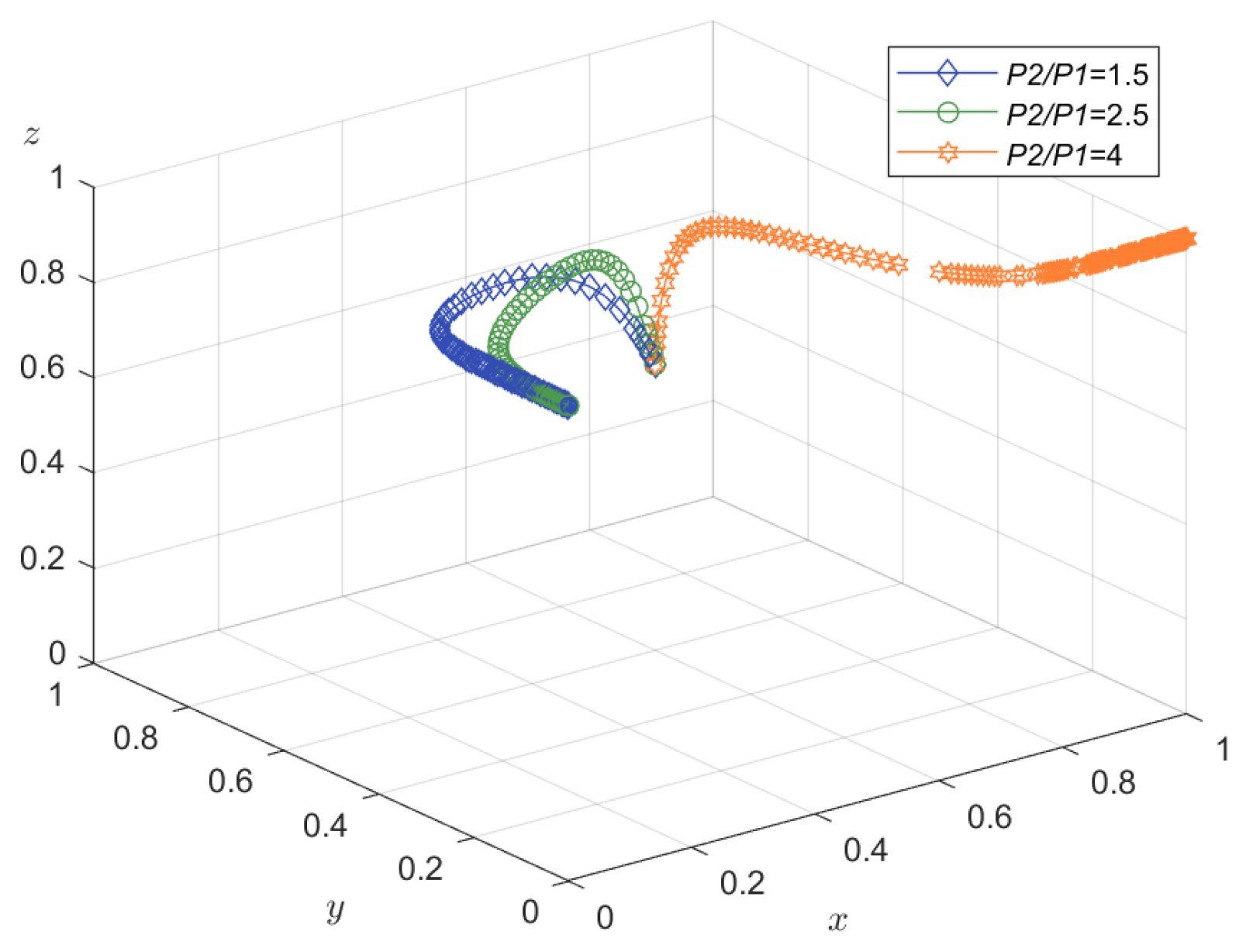

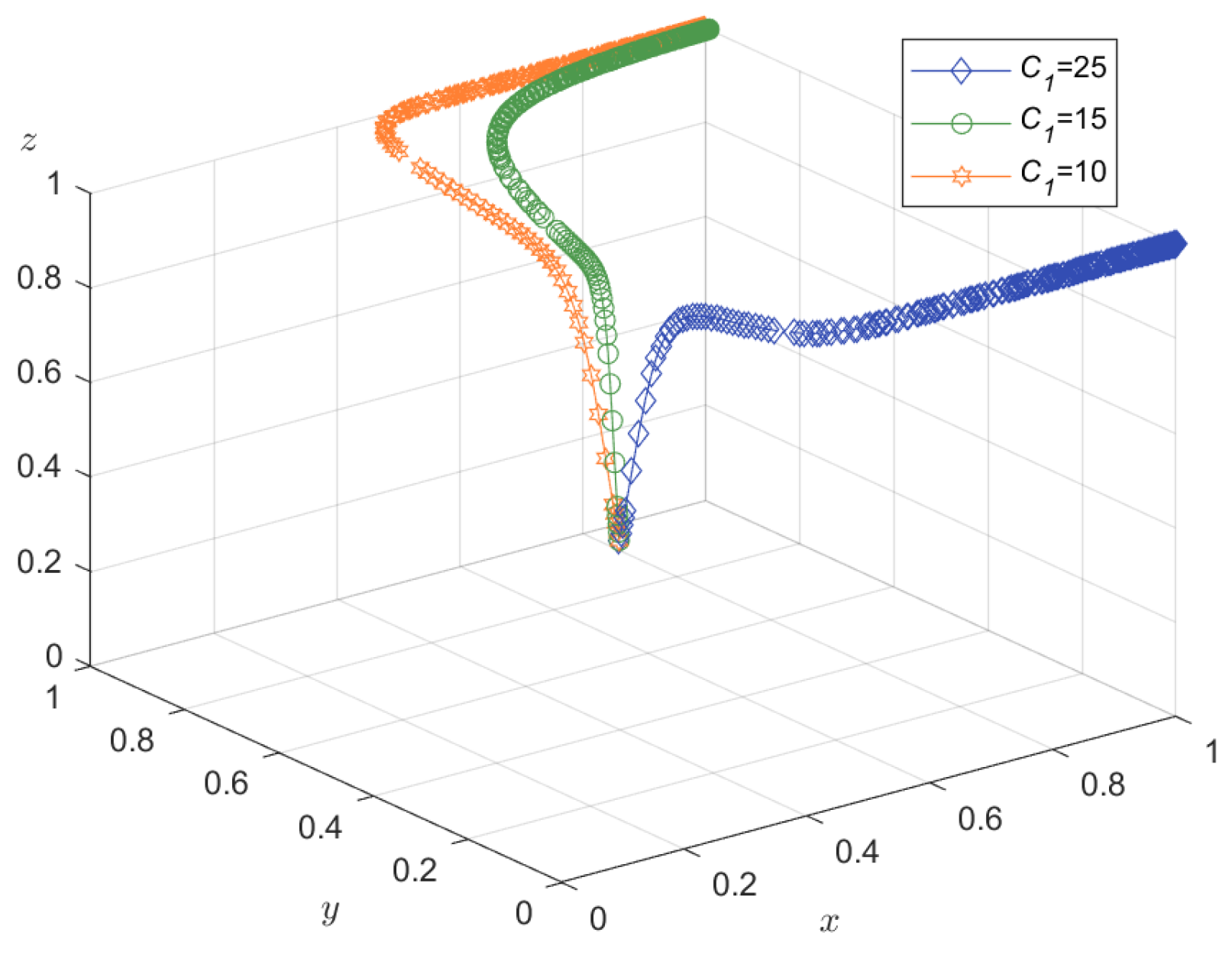

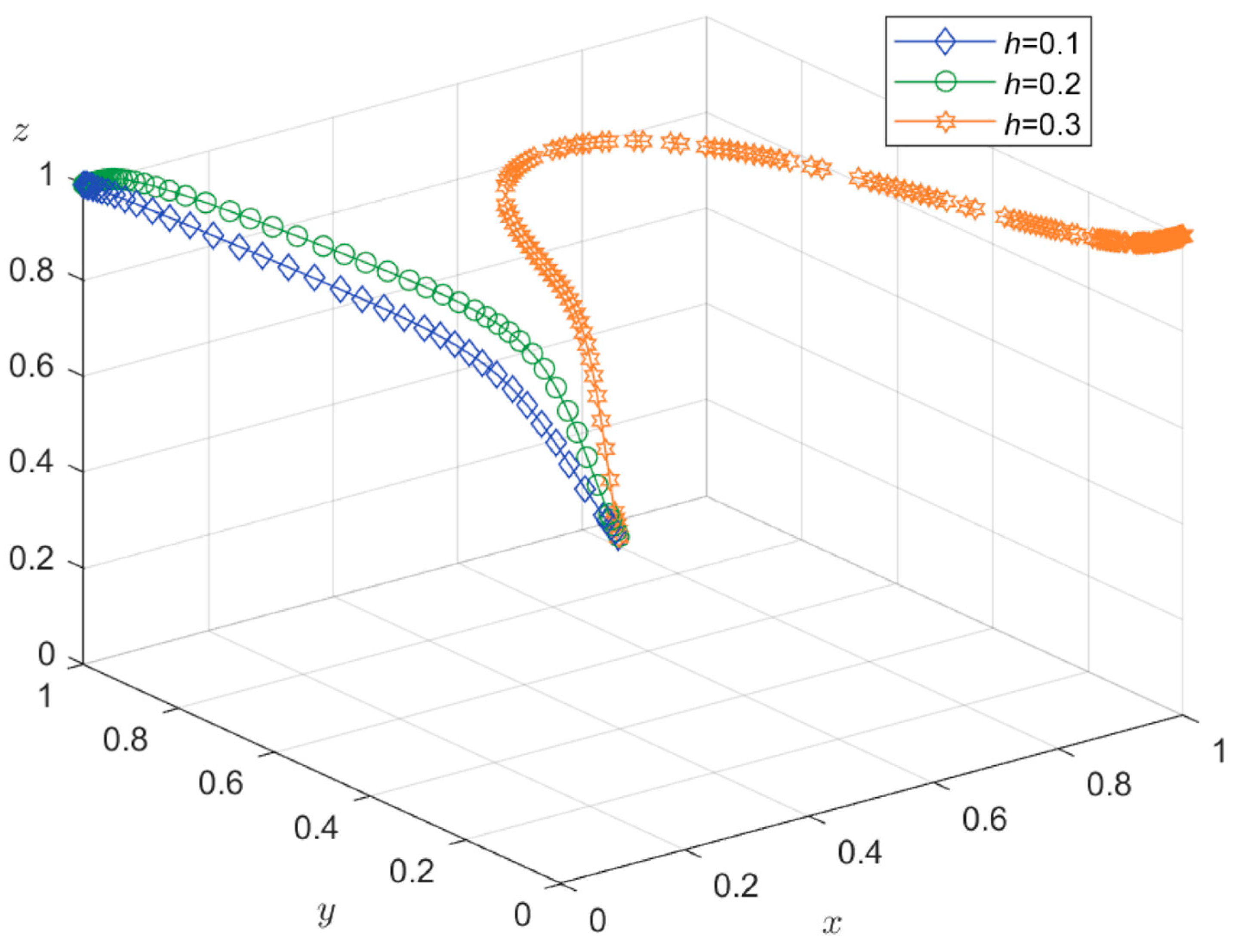
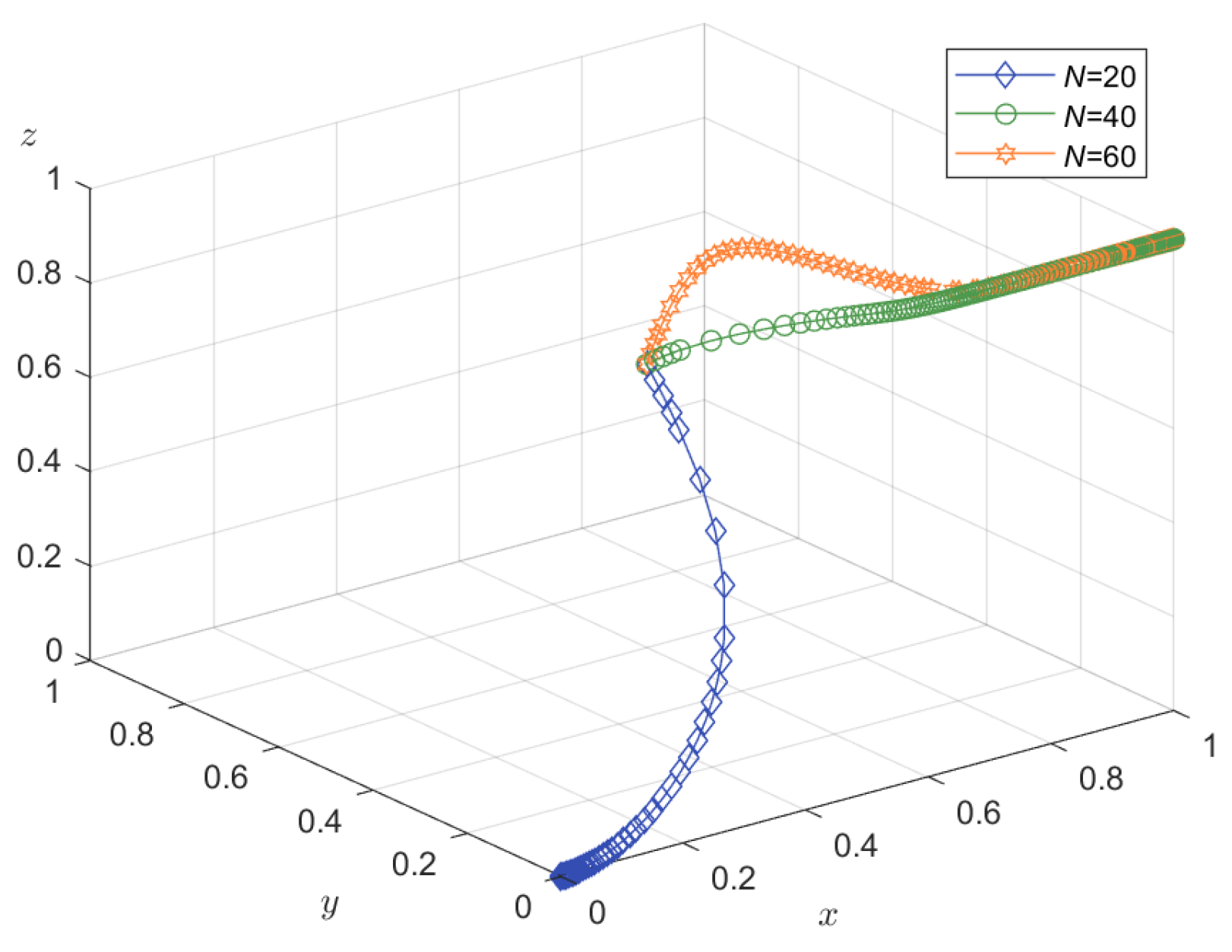
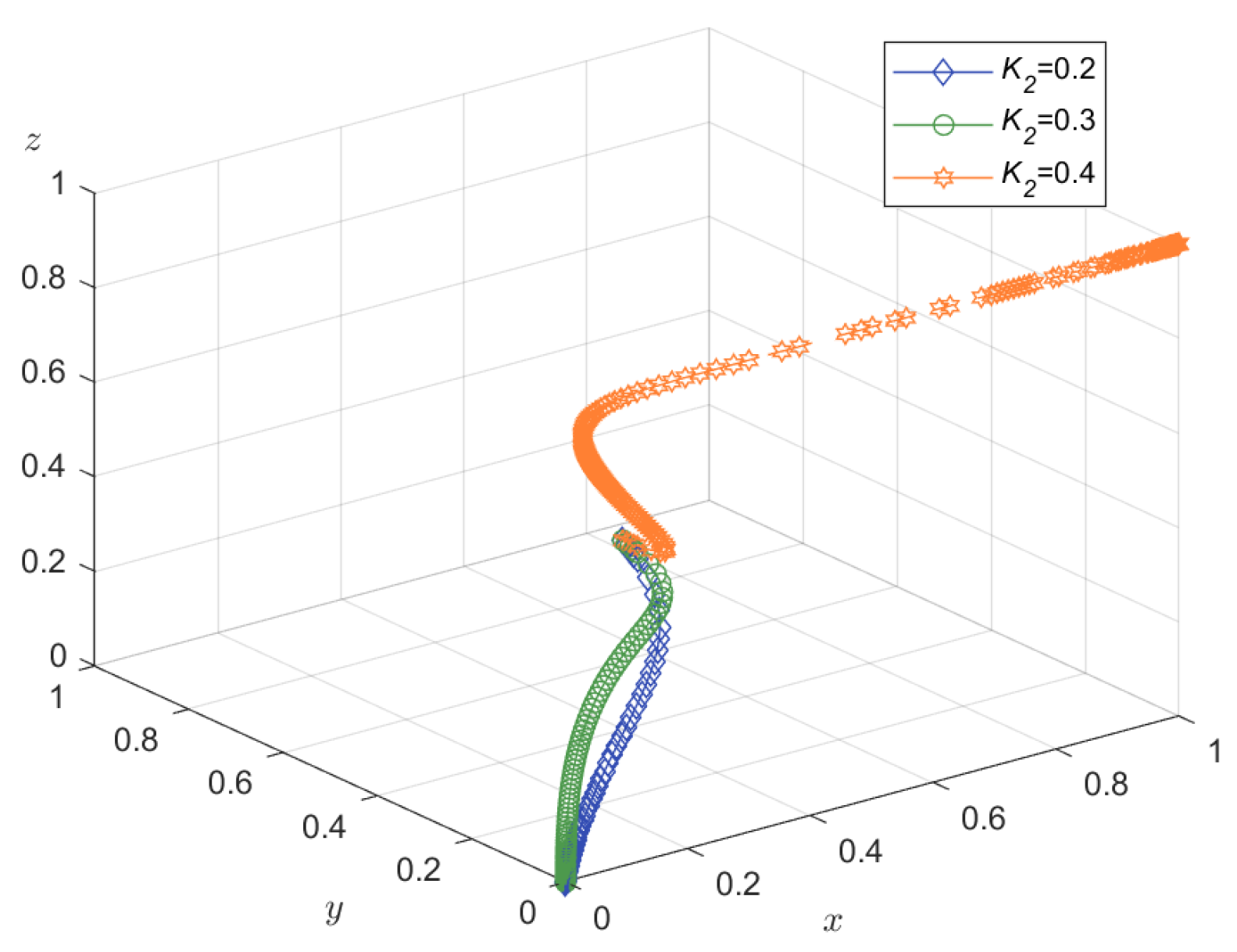

| Parameters/Terms | Meanings |
|---|---|
| x | The probability of social media influencers choosing strict quality control. |
| y | The probability of a platform choosing strong supervision. |
| z | The probability of consumers choosing to defend their rights. |
| h | Platforms taking a cut of the earnings from social media influencers. |
| a | The positive impact on revenue when influencers choose lax quality control. |
| R | The benefits for social media influencers when they choose strict quality control. |
| The possibility of product problems when influencers choose strict/lax quality control. | |
| Additional costs coming from a platform’s strong supervision. | |
| F | The extent to which platforms penalize social media influencers who sell poor quality products. |
| E | The reputation loss for influencers when consumers defend their rights and the platforms choose weak supervision. |
| b | The positive impact of strong supervision on market order. |
| J | When a platform chooses strong supervision, consumer rights protection brings market governance benefits to the platform. |
| The commercial loss caused to the platform when social media influencers choose strict/lax quality control. | |
| N | The functional value benefits that consumers receive from purchasing products. |
| W | The emotional value benefits that consumers receive from purchasing products. |
| The cost to consumers of defending their rights. | |
| The probability of effectively addressing the consumer rights protection problem when a platform chooses strong/weak supervision. | |
| S | Compensation for successful consumer rights protection. |
| G | Loss of consumer equity due to product quality problems. |
| The expected returns of social media influencers under a strict quality control strategy. | |
| The expected returns of social media influencers under a lax quality control strategy. | |
| The average returns of social media influencers under strict and lax quality control strategies. | |
| The expected returns of the platform under a strong supervision strategy. | |
| The expected returns of the platform under a weak supervision strategy. | |
| The average returns of the platform under strong and weak supervision strategies. | |
| The expected returns of consumers under the rights protection strategy. | |
| The expected returns of consumers under no rights protection strategy. | |
| The average returns of consumers under rights protection and no rights protection strategies. | |
| The rate at which a strategy’s proportion in a population changes over time is proportional to its relative benefit. | |
| A strategy that can resist invasion by alternative strategies during the process of natural selection. |
| The Platform | Consumers | Social Media Influencers | |
|---|---|---|---|
| Strict Quality Control () | Lax Quality Control () | ||
| Strong supervision (y) | Defend their rights (z) | ||
| Do not defend their rights () | |||
| Weak supervision () | Defend their rights (z) | ||
| Do not defend their rights () | |||
| Equilibrium Points | Eigenvalue | Eigenvalue | Eigenvalue | Symbolic Judgement |
|---|---|---|---|---|
| ESS | |||||
|---|---|---|---|---|---|
| a | |||||
| b | |||||
| h | |||||
| R | 100 | 100 | 100 | 100 | 100 |
| F | 50 | 50 | 50 | 50 | 50 |
| E | 20 | 20 | 20 | 20 | 20 |
| S | 50 | 50 | 50 | 50 | 50 |
| 25 | 25 | 25 | 10 | 10 | |
| 5 | 5 | 5 | 5 | 5 | |
| N | 20 | 50 | 50 | 20 | 50 |
| W | 50 | 20 | 20 | 20 | 20 |
| G | 10 | 10 | 10 | 10 | 10 |
| J | 5 | 5 | 5 | 15 | 5 |
| 10 | 10 | 10 | 10 | 10 | |
| 15 | 15 | 30 | 15 | 15 |
Disclaimer/Publisher’s Note: The statements, opinions and data contained in all publications are solely those of the individual author(s) and contributor(s) and not of MDPI and/or the editor(s). MDPI and/or the editor(s) disclaim responsibility for any injury to people or property resulting from any ideas, methods, instructions or products referred to in the content. |
© 2024 by the authors. Licensee MDPI, Basel, Switzerland. This article is an open access article distributed under the terms and conditions of the Creative Commons Attribution (CC BY) license (https://creativecommons.org/licenses/by/4.0/).
Share and Cite
Song, Y.; Kong, Y. Tripartite Evolutionary Game Analysis of Product Quality Supervision in Live-Streaming E-Commerce. Mathematics 2024, 12, 2446. https://doi.org/10.3390/math12162446
Song Y, Kong Y. Tripartite Evolutionary Game Analysis of Product Quality Supervision in Live-Streaming E-Commerce. Mathematics. 2024; 12(16):2446. https://doi.org/10.3390/math12162446
Chicago/Turabian StyleSong, Yang, and Yijun Kong. 2024. "Tripartite Evolutionary Game Analysis of Product Quality Supervision in Live-Streaming E-Commerce" Mathematics 12, no. 16: 2446. https://doi.org/10.3390/math12162446





